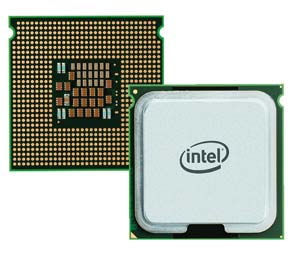IntelÝs next generation Xeon processor, the 5100 series, has arrived. Codenamed Woodcrest and based on the much hyped Core 2 Duo processor, Intel finally has the chip to take the fight to AMD, says Greg Corke.
Intel has spent the last few years playing second fiddle to AMD in the workstation benchmark charts. After a lengthy time in the wilderness AMD finally earned its spurs in the workstation space following the excellent performance and scalability of its Opteron processor.
It was the specialist System Integrators that first acknowledged the potential of the Opteron, and following on from this the major workstation OEMs couldnÝt afford to ignore AMDÝs 64-bit processor any longer. Demand by power hungry CAD/CAM/CAE and DCC users was just too strong. As a result, Fujitsu Siemens and IBM added Opteron-based machines to their workstation families in 2004, and HP followed soon after. Today, the only OEM not to offer AMDÝs Opteron in its workstations is Dell.
With the sudden widespread availability of Opteron in the workstation sector, Intel took a knock, particularly at the high-end, and needed to respond with some cracking technology. For months the industry has been talking about IntelÝs next generation processor, and with its new Core 2 Duo-based Xeon processor out now, the California chip giant has certainly got something to shout about.
• Xeon 5160 (3.0GHz, 1,333 MHz FSB)
• Xeon 5150 (2.66GHz, 1,333 MHz FSB)
• Xeon 5140 (2.33GHz, 1,333 MHz FSB)
• Xeon 5130 (2.00GHz, 1,333 MHz FSB)
• Xeon 5120 (1.87GHz, 1,066 MHz FSB)
• Xeon 5110 (1.6GHz 1,066 MHz FSB)
Codenamed Woodcrest, the Xeon 5100 series is the workstation/server specific chip from the Core 2 Duo family, a new generation of desktop processors from Intel. Core 2 Duo marks the first major architectural change that Intel has implemented since the turn of the millennium. Out goes ÙNetburstÝ, which arrived with the Pentium 4, from here on in itÝs all about the new ÙCoreÝ architecture.
So what exactly is the new Core 2 Duo-based Xeon chip? The Woodrest Xeon features a shorter pipeline, and boasts 4MB of on-die L2 cache, which is shared between the two cores, and means it can assign a single CPU the full 4MB if required. The Xeon 5100 series also features a lightning fast 1,333MHz Front Side Bus (FSB) in all but the low-end Xeons. Naturally, there is support for IntelÝs EM64T technology, meaning it can run both 32-bit and 64-bit Windows and applications.
The Xeon 5100 family has a total of six models, ranging from the modest 1.6GHz Xeon 5110, up to the 3.0GHz Xeon 5160. While this apparent drop in GHz from the previous generation Xeon processors will be confusing to many, what it actually means is that Woodcrest is far more efficient at processing per clock cycle. Indeed, our tests show that a 2.66GHz Xeon 5150 is still far faster than a previous generation Xeon running at 3.6GHz. As IntelÝs dedicated workstation chip, you can put two Xeon 5100s in a single workstation giving you a total of four cores to cut through multithreaded operations like rendering.
When it comes to backwards compatibility, Woodcrest earns full marks as it comes in the same LGA775 package, which was used for the Pentium 4 and Pentium D, so existing motherboards will be able to accept the new processor, usually following a simple BIOS update.
One technology that is notably absent from Woodcrest is hyperthreading, which transforms each CPU into two logical processors. Hyperthreading was available in IntelÝs Pentium 4 and older Xeons, but the jury is still out on the technology which only worked well with certain multi-threaded applications, and actually slowed down performance under others.
Energy efficiency
Intel has been slated in recent years for the amount of power its processors draw, and hence the amount of heat they produce. Indeed, this contributed to the success of AMDÝs Opteron, particularly in blade server environments where cooling can be a major problem. The marketing folk at Intel have naturally been quick to pick up on this and are making big noises about WoodcrestÝs Ùindustry leadingÝ power consumption and excellent performance/watt ratio. In addition, like IntelÝs mobile chips, Woodcrest is able to shut down parts of the processor when not in use, saving further power. .
So what exactly does all this mean? Well quieter workstations for one, as cooling fans donÝt need to work as hard, but companies can also save a lot of money by reducing power consumption and cutting down on air conditioning costs to combat the amount of heat that high concentrations of workstations produce ± and when you look at the wider picture, itÝs also doing its bit for global warming.
Believe the hype
From our preliminary benchmark tests on Woodcrest, IntelÝs new workstation processor certainly lives up to the hype. Our Dell Precision 690 test machine which featured two dual 2.66GHz Xeon 5150 processors, set new records in all of our CAD application benchmarks. And letÝs not forget that Intel still has a faster processor in the Woodcrest family, the Xeon 5160, which runs at 3.0GHz.
Conclusion
With Woodrest, Intel has produced the fastest and coolest processor on the planet, which is destined to become a huge success in the workstation sector. AMD certainly has a fight on its hands and it will be extremely interesting to see how things pan out over the coming months. While IntelÝs new Xeon 5100 series is certainly revolutionary, AMDÝs Opteron is currently in an evolutionary phase and it remains to be seen if the addition of DDR2 memory in its new generation 1000 series will be enough to keep its workstation crown.
Looking to the future, both AMD and Intel should have quad core processors ready for early 2007 (or by the end of year, according to some reports), which will put buckets of multiprocessing in the hands of design visualisation users, and then the scalability of AMDÝs and IntelÝs architectures will really be put to the test.






